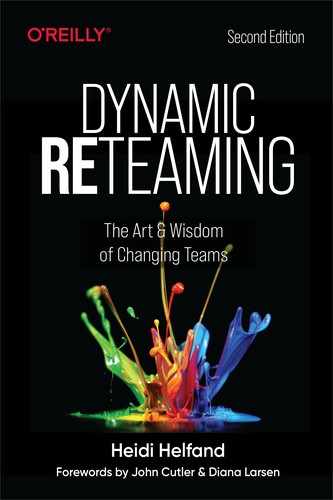Part IV. Conclusion
Companies, teams, and people evolve and change. Sometimes changes just happen and we need to adapt to them or leave. Other times we catalyze the change with the hope that we are going to have a better outcome in our workplace.
In this book I have gone over what dynamic reteaming is, why it happens, and how it shows up as regular patterns: one by one, grow and split, isolation, merging, and switching. I’ve also gone over anti-patterns and have shared some rather sad, and what I think are upsetting, stories about reteaming.
I’ve shared several tactics from the trenches that you can employ before and after dynamic reteaming to help you become more successful with it, such as planning your reteaming initiatives, transitioning over to your new teams, calibrating the new teams, and having retrospectives to propel your learning around this concept.
What really amplifies reteaming and makes it feel more dynamic is when it happens on multiple levels, simultaneously. We might be part of a growing startup that is doubling or tripling in size. Changes in that situation happen at all levels of panarchy: the individual level, the team level, the tribe level, the company level—and even at the global level. The more it happens on the different levels, the more dynamic it might feel. As humans, sometimes we might feel excited and motivated by all of this change. Other times, change feels like a punch in the gut, and it takes time and empathy from our leaders and teammates to pull through.
One day we might realize that our company has doubled in size, and we may feel the need to come together to gel as one company again, or we might feel like things have changed so much that it’s time for us to leave. And at other times we have no choice but to adapt to the changes in order to survive. I hope this book has given you ideas so that you don’t just survive dynamic reteaming but thrive in it.
On the flip side, we might be in an organization that moves as slow as a glacier, and then the work to be done is trying to catalyze change to bring renewal to our stagnating situation. We desire, more than anything else, to get some creative destruction, a.k.a. dynamic reteaming, in order to bring some life back into our company. It can be done.
These two extreme examples typify dynamic reteaming. Sometimes the reteaming is dynamic and multilevel, and other times we try our darndest to “reteam the dynamic” or shift the dynamic to get out of our organizational funk. Doing either involves humans, and can get messy. People want different things, and our uniqueness is a blessing, but also makes reteaming hard to do and quite complex.
The fact is, some of us prefer more change and stimulation, and some of us prefer less. Maybe that’s why we join different types of organizations—some of us want the crazy speed of high change, and others prefer a more serene setting with less change. It’s not that one setting is better than another; it’s more about choice and preference, if we have that luxury. If we are lucky, we will join a company that has great parity in its hiring, with the actual experience working at the company. That way, we’ll have an idea of what we’re getting into.
Human emotion can shine brightly through reteaming. It can feel primal. And, sometimes reteaming feels like it rips our hearts out. Our friends get laid off, we might get fired, or the company hires a leader that we do not prefer for whatever reason. Other times reteaming feels like it relieves pressure, or that it liberates us from undesirable situations like the diffusing of a ticking time bomb, or the firing of a colleague that we abhorred.
Results may vary. Some of our reteamings are going to go well, and some of them are going to fail. This stuff is hard. And the more people we try to deliberately reteam, the trickier it might be. Other times, even what seems like a manageable reteaming might not work out. But many times it does. The key is to learn your way forward together, and build the capacity of becoming an adaptive organization. Be brave.
And that’s the key—reflection and learning. Invest the time to plan out your deliberate reteamings. Include the people in the decision making and have respect. Consider your individual contributors as partners in your efforts to improve your workplace. Because that’s what we’re trying to do with reteaming—have a better, more effective working life.
Use the power of the retrospective to talk about how things went with your reteaming. Share what you are learning with your colleagues. Don’t just move on and pass over the process of learning, even if you feel that you are too busy to stop and care. Schedule the time on the calendar to process what happened, and carry the learning forward.
It’s my hope that this book has helped you to see the software industry a bit differently. The quest for team stability is unrealistic and not helpful in companies where change is more the norm than ever. It’s my hope that you will go forth, reflect on your own team compositions, and catalyze the changes that you and your teammates believe will help you get to a better place. Take charge of your teams. If you don’t, someone else will. Because, whether you like it or not, “Team change is inevitable. You might as well get good at it.”
